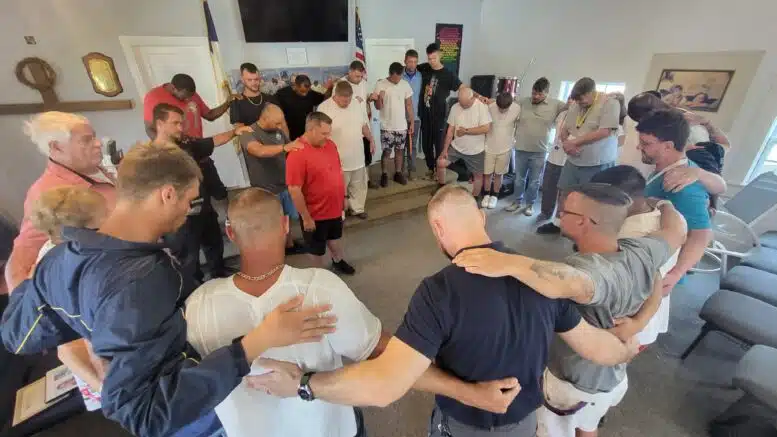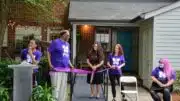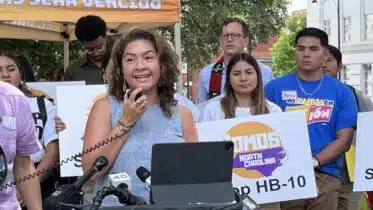By Grace Vitaglione
Near the end of the recently recessed legislative session, the N.C. House of Representatives made an extensive budget proposal on how to spend part of the funds received by North Carolina as part of a nationwide settlement over the marketing of opioid drugs.
North Carolina will receive $750 million of the funds over 18 years from the agreement reached with drug companies for their alleged roles in fueling the opioid epidemic. As part of the settlement, state lawmakers receive 15 percent while the counties are on the receiving end of the bulk of the funds.
While counties are restricted to spending options that compel them to use evidence-based interventions, lawmakers are not as constrained by those restrictions on how to appropriate the settlement money under their control.
The House’s budget plan for the fiscal year that started July 1 would have given over $23 million to 25 counties and $5.4 million to 10 recovery centers, with few details on how the money should be spent other than boilerplate language stating, “Funds are provided from multi-state opioid settlements and will be used to respond to the negative impacts of the opioid epidemic.”
But all expenditures are not the same, and some experts on opioid use disorders raised concerns that the funds weren’t primarily directed to facilities that provide evidence-based treatment such as medication for opioid use disorders, which has become the “gold standard” for treatment. For example, three centers on the list don’t allow clients to use medications for opioid use disorders while they are staying at the facility. Some of the facilities in the House proposal are unlicensed.
Debates over how these dollars could and should be spent have been ongoing since the money started to flow in 2022.
Although larger spending negotiations fell apart, it’s likely the conversation over opioid dollars at the General Assembly isn’t over.
Budget details
Representative Wayne Sasser (R-Albemarle) said he’d like to get every county in the state at least $1 million for responding to the opioid crisis. In the failed House budget, 25 counties — mostly those represented by Republican lawmakers — were the target for dollars.
Sasser said some of the individual recovery centers that made it onto the list asked him to include them.
Sasser also said he also worked with Robin Hayes, founder of Bridge to 100. Hayes previously was the head of the state GOP and pleaded guilty to lying to the FBI in 2019 as part of a bribery scandal. He was pardoned by Donald Trump in January 2021.
Hayes now runs the new nonprofit corporation, which aims to help secure opioid settlement funds for “faith-based rehabilitation centers” in all 100 counties. Eight of the 10 centers in the budget are listed as supported providers on Bridge to 100’s website.
Hayes said he isn’t against medication for opioid use disorders, but his focus is on faith in recovery. There are lots of options for dealing with the opioid crisis, he said, and centers such as these should be one of them.
Licensed facilities are subject to state requirements. Under current state law, a charitable, nonprofit, faith‑based, adult residential treatment facility doesn’t have to be licensed as long as it doesn’t receive any federal or state funding. But a provision in the House budget plan aims to allow those unlicensed facilities to receive opioid settlement funds.
A spokesperson for NCDHHS wrote in an email that the language was added “to clarify and ensure that individuals or organizations that are currently excluded from licensure requirements do not lose that status solely on the basis of receiving opioid settlement funds.” While DHHS did not determine the language, the spokesperson said the department did flag the need for clarity around that language.
Jennifer Carroll, a medical anthropologist at N.C. State University who specializes in drug use and overdose prevention, said that was concerning because it could mean less accountability for centers receiving opioid settlement funds.
Medications effective at preventing overdose deaths
Research has shown that medication for opioid use disorders greatly reduces the risk of overdose death, particularly at the beginning of treatment.
The three FDA-approved medicines for the disorder are methadone, buprenorphine and naltrexone. Methadone and buprenorphine are medications that stimulate the same parts of the brain as commonly abused drugs, which can dampen the cravings that users have for the drugs while not producing the same “high.” Methadone and buprenorphine have been widely studied and have better survival profiles and more data to back up their efficacy.
Naltrexone blocks the body’s ability to get high from opioids, but it doesn’t do anything to stop cravings. It also doesn’t seem to protect against overdose deaths quite as well, according to Eric Morse, an addiction psychiatrist in Raleigh and CEO of Morse Clinics, which provides medications for opioid use disorder.
The limited funding coming from the national settlement should prioritize evidence-based treatment such as medication, he argued.
“You have a certain amount of opioid settlement funds, we should be spending it on forms of treatment that save lives,” he said.
Meanwhile, people who attend an abstinence-based inpatient program are likely to relapse once out of the program, according to Blake Fagan, a family physician who oversees the Mountain Area Health Education Center’s office-based treatment program in Asheville for substance use disorders. And because their tolerance has likely decreased at that point, they’re at higher risk of overdosing and dying, he said.
Carroll researches the lived experiences of substance use and the impacts of drug policy on the health and wellness of people who use drugs. For a yet-unpublished study, her team called residential providers of substance use treatment around the state in spring 2023 to find out whether they allowed clients to use opioid agonist treatment like buprenorphine at the facility. Only 20 out of 68 said they did.
Carroll said the team found the most common type of provider was a faith-based, abstinence-only, unlicensed facility that bars medication and requires people to work without pay, often in enterprises owned or related to the facility.
“A number of licensed places told our callers patently false things about these medications in order to deter them from seeking those medications there or somewhere else,” she said. “That I find particularly troubling.”
Some legal experts said work requirements without pay were legally questionable, NC Health News reported previously. A U.S. Supreme Court ruling suggests nonprofits that run businesses without paying employees could violate the Fair Labor Standards Act.
Three centers listed in the House budget proposal forbid clients to use the medications while at their facility, including Gateway of Hope Addiction Recovery Center, Adult and Teen Challenge of Sandhills and Charlotte Rescue Mission.
Bethel Colony of Mercy was also listed in the budget document. According to Pastor Paul Pruitt, executive director, the center allows clients already taking naltrexone to continue. But the other two medications aren’t allowed because they’re “abused among addicts,” he wrote in an email.
Freedom House of Greensboro doesn’t allow clients to take buprenorphine, according to Carroll’s research team. The center did not respond to requests for comment.
Some medical and legal experts have said it’s in violation of the Americans with Disabilities Act to deny recovery services such as housing to people using medications for opioid use disorder.
Medication costs
Hayes pointed out that the medications can be expensive. His aim with Bridge to 100 is to support centers that are low to no cost, he said.
Place of Grace in Rockingham is one of the centers listed that provides housing and services free of charge, according to Pastor Gary Richardson.
Christian Recovery Centers is free until the last phase of the program, at which point it costs $170 a week, according to CEO Josh Torbich.
Carroll pushed back, noting that the cost of medication is a symptom of greater issues in the health care system.
“The fact that insulin prices are unreasonable doesn’t mean we should stop treating diabetes, right?” she said.
Morse, CEO of Morse Clinics, noted that if a client isn’t covered by insurance, the cost of getting medicine at his clinic is $80 a week. That aligns with what other clinics report. For example, at the Mountain Area Health Education Center, it may cost between $55 and $120 for a month’s supply of medicine without insurance, according to Fagan.
Combining approaches
While almost none of the recovery centers listed in the House budget plan provide medication for opioid use disorder, three said they allow their clients to take it while receiving services. Those include Place of Grace, Will’s Place and Bethel Colony of Mercy, which allows naltrexone.
Christian Recovery Centers provides medication through a partnership with Southeastern Integrated Care, Torbich said. Clients can receive medication in the first four to six weeks with the goal of tapering off before moving further into recovery, he said.
Torbich said the rate of those who drop out of the first period, called the “motivational track,” decreased by about 23 percent in the past three months since the program coupled it with clinical services and medication.
“We’re one of the only places that I know of that offer clinical treatment services, a 12-step program like [Alcoholics Anonymous], and we’re still a faith based model,” he said.
As to why clients are encouraged to taper off, he said the purpose of the program is to support people who want independence from the medication, such as having to work around appointments.
Morse said centers who say they allow medication could still make it hard for someone to access it, such as not providing transportation.
Hayes said he’s hoping new research from the Social Innovation and Entrepreneurship Lab at the UNC Chapel Hill School of Social Work will demonstrate the success of the faith-based recovery centers.
The research team started designing an evaluation in June that would be performed with three pilot programs at Ground 40, Hope Center Ministries and Christian Recovery Centers, according to Gary Nelson, director. The team plans to gather stakeholders to help come up with several outcomes to define success, Nelson said.
Usually a recovery that “sticks” involves multiple factors, he said. Faith can be one of them, as it may give someone a sense of direction or the idea that someone has their back, he said.
What centers/counties need the money for
Montgomery County was on the budget to receive $1.5 million from lawmakers for the opioid crisis.
Overdose deaths are a significant problem in the county, said John Shaw, chair of the Montgomery County Board of Commissioners.
“I’m tired of going to funerals,” he told NC Health News.
Montgomery County received grants to buy naloxone, also known by the brand name Narcan, and hire a peer support specialist — someone in recovery with mental illness and/or substance use disorder who supports individuals also struggling with those challenges, he said.
Additional funding from the legislature would help the county start a Law Enforcement Assisted Diversion program, Shaw said. That allows law enforcement officers to redirect low-level offenders involved with substances to community-based services.
Hyde County was in the budget to be appropriated $1 million. The county has three peer support specialists, as well as syringe exchange and naloxone programs, according to Luana Gibbs, health director at the county health department.
More money would allow Hyde to strengthen those programs, Gibbs said.
Gibbs said her son Ryan died of an overdose at 23 years old in 2017. He and his girlfriend thought they were buying cocaine, but it was heroin laced with fentanyl, she said.
That sparked her work addressing the opioid crisis in Hyde, she said. It’s important to educate young people about drugs, Gibbs said.
“People like my son Ryan need to know and understand,” she said. “You can’t just say, ‘just say no.’ That doesn’t work.”














